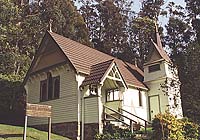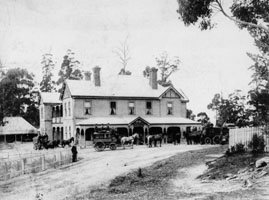Fern Tree A Very Special Place
Fern Tree
A Very Special Place

‘We enjoyed a draft of the cold crystal water
from the murmuring spring’
(c)Irene Schaffer 2010
The first decision that was to have an importance for Fern Tree was the overland rout from Hobart to the Huon and the second was the necessity to augment Hobart’s first water supply for city needs. (Report 1 page 24)
The significance for Fern Tree of the tapping of Brown’s River for the water supply, where a masonry intake basin was built, was that enter to what became known as the Fern Tree Bower became possible. Together the Huon road works, and the Hobart waterworks construction in quite a short time had opened up the potential of the whole Fern Tree area.
(report 1 pages 30-3)
Description of how the work was carried out is fully explained in Lindy Scripps book “The Pipeline Track Mt Wellington” from which I quote.
‘At a typical wooden aqueduct site somewhere around, say, Fork Creek, with the survey work pegged out, a gang of eight labourers would excavate a trench two feet deep. To keep the trench on the right decline, sometimes rock had to be cut through, while in other places ground had to be raised using stone waste. Meanwhile, bushmen nearby felled Stringy Bark, sawed and split and adzed the trunks into good straight slabs and bought them to lie in the trench to form the bottom and sides of a wooden trough. Where two wooden slabs needed joining Huon Pine plates were fixed underneath and trunnels (wooden peg nails) were hammered in to hold the pieces together. To prevent leaks, all joints, all joints were filled with oakum (hemp fibres) and ‘cold tar laid on hot’ Finally, a top slab was hammered down over the complete trough and the whole covered with earth to protect the pipeline from bushfires and falling trees. It was relatively cheap but economical, especially in the remoter parts of the works. And it was remote work. On the higher tributaries of Brown’s River Creek the workman camped in the bush for weeks at a time (just as Frankland’s convicts in their three huts)……………………’
To bring the pipeline across Longhill creek (now Dunn’s Creek) stonemasons built a seven – arched aqueduct with sandstone piers 40 foot high. The conduit itself was cut from solid stone. At Hall’s Saddle where the wooden trough was to meet the stone channel, builders were at work on a sluice house.’

Pipe Track
The first Fern Tree Inn was in existence by 1861 when Alfred Hall – who had a large grant in the area – was granted a license for operation. ( Public Licensing Book 1861 LSC269/4. AOT. Report 1 page 32)
It is probable that the inn was established to cater for what would become a new passing coach trade to the Huon.

Fern Tree Hotel 1909
Mt Wellington and Fern Tree
1789 - George Bass climbed Mt Wellington leaving Flinders at Prince of Wales Bay and walking to what is now Lenah Valley before ascendingto the summit.
1825 - Convicts sent to the Springs and began digging a diversion channel, 1ft wide and 2ft deep to create a gentle even fall towards the Hobart Rivulet. These convicts first laid troughing slabs either timber or wood Stone. This work was never finished.
1827 - Letter from Thomas Scott the Surveyor to Ronald Gunn regarding the
tree ferns growing upwards of 16ft by 2ft diameter.
1828 - The completed duct caught the flow of the mountain’s springs that fed Brown’s River (which now flows to Kingston) and diverted its flowtogether with the Springs waters themselves into the Hobart Rivulet. This was abandoned when the new Waterworks began in 1860.
1831 - First major piped water supply built from the Springs to the Cascades.
1852 - Mt Wellington being cleared of large timber. 550 loads of fire wood
was used by Hobart residents per week.
1856 - First 5 miles of road was available by Sandy Bay Rivulet, going
towards Halls Saddle and on to what was later become Fern Tree.
1856 - Parcels of land taken up at Fern Tree.
1858 - 4 miles of pipe and ducts had been laid around the foothill of Mt Wellington.
1859 - Work started at Fork Creek (above Fern Tree) and at the Waterworks (Sandy Bay Rivulet) at the same time proposing to meet somewhere near Hall Saddle (Ridgeway)
1861 - During road work on the Huon Road were being undertaken pipeline infrastructure had been extended to tap the steams of Brown River and Fork Creek. (near Neika)
1861 - First Fern Tree Inn owned by Alfred Hall. Licensed 1861.
1861 - Proposed building of the Waterworks from two new springs at Fork Creek (The Wishing Well) Brown’s River Creek and when neededfrom further springs.
1861 - Waterworks opened 5 March beer was drank but not water.
1869 - Huon Road to Fern Tree completed, lots of timber taken out during this time.
1875 - Alfred Randell shows different types of material used to carry water.
1888 - Construction of Pillenger Drive began using convict labour.
1892 - St. Raphael Church built.
1899 - Population of Fern Tree was 30 with 15 being farmers and 4 boarding
1902 - New hotel built at Fern tree to replace the 60 year old Fern Tree Inn
houses.
1910 - Population of Fern tree was still 30 with 15 farmers and 4 boarding including the Springs Hotel houses.
1921 - Population of Fern Tree increased to 39 with 11 farmers and 5 boarding houses.
Books used in gathering information for this talk.
The Water Getters. by Bernard Lloyd.
The History of Mount Wellington. by Elizabeth de Quincey.
Some Historical Findings and a Cultural Heritage of Fern Tree Report 1. by Gwenda Sheridan.
The Pipeline Track Mt Wellington” Lindy Scripps
Henry Woods the old man of the Mountain. By Irene Schaffer.
Booklet containing photo can be obtained from me.
irene.schaffer@bigpond.com